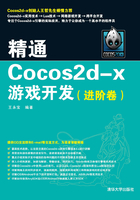
上QQ阅读APP看书,第一时间看更新
1.5 读写二进制文件
严格来说所有的文件都是二进制格式,二进制文件一般会对应一些数据结构。可以直接将自定义的数据结构存储到文件中,读写都很方便,而且在读写的过程中,可以很轻松地添加加密解密的操作,安全性高,效率也快,不需要像前面的其他格式,逐个解析数据,而是直接取出内存,然后结构体强制转换,直接使用。由于是自定义的格式,所以可以自定义各种后缀,如以dat结尾,或者以sys结尾都可以。
首先来了解一下简单数据结构读写,现在定义一个数据结构,来存储玩家的名字、等级、金币、经验等信息。注意,数组必须是固定长度的,如果是不固定长度的数组,可以参考下面读取动态数据结构的方法。
//定义玩家信息结构体
struct PlayerInfo
{
char Name[32];
int Level;
int Money;
int Exp;
};
//填充这个结构体
PlayerInfo info;
memset(&info, 0, sizeof(PlayerInfo));
strncpy(info.Name, "BaoYe", sizeof(info.Name));
info.Level = 10;
info.Money = 888;
info.Exp = 0;
//注意这里是getWritablePath,获取一个可写的路径
string path = FileUtils::getInstance()->getWritablePath();
path.append("user.dat");
//文件打开的方式是wb二进制方式写入
FILE* fd = fopen(path.c_str(), "wb");
if (NULL == fd)
{
return false;
}
//写入文件并关闭
int count = fwrite((char*)&info, 1, sizeof(PlayerInfo), fd);
fclose(fd);
CCLOG("Write File %s\n Size %d", path.c_str(), count);
上面的代码将信息写入到文件保存起来了,接下来将其读出来。
string path = FileUtils::getInstance()->getWritablePath();
path.append("user.dat");
PlayerInfo info;
//文件打开的方式是rb二进制读取
FILE* fd = fopen(path.c_str(), "rb");
if (NULL ! = fd)
{
//取出来就可以用了
fread(reinterpret_cast<char*>(&info), 1, MAX_BUFFER_SIZE, fd);
}
CCLOG("Read File %s\n name %s level %d money %d exp %d",
path.c_str(), info.Name, info.Level, info.Money, info.Money);
接下来看一下动态数据结构读写,我们定义一个背包的数据结构,动态数据的读写会稍微麻烦一些,也比较容易出错,但还是可以轻松搞定的。因为是动态的,所以数据结构尽量简化一些。
//物品信息结构体
struct Item
{
int id;
int count;
};
char buf[MAX_BUFFER_SIZE];
//先把背包中物品的总数写入
*(int*)(buf) = 10;
//后面的内容是背包中所有物品的信息
Item* bag = (Item*)(buf + sizeof(int));
for (int i = 0; i < 10; ++i)
{
bag[i].id = i;
bag[i].count = 3;
}
string path = FileUtils::getInstance()->getWritablePath();
path.append("bag.dat");
FILE* fd = fopen(path.c_str(), "wb");
if (NULL == fd)
{
return false;
}
//写入文件并关闭,写入的长度是动态计算出的内存大小
//一共写入了1个int和10个Item
int count = fwrite(buf, 1, sizeof(int)+sizeof(Item)* 10, fd);
fclose(fd);
CCLOG("Write File %s\n Size %d", path.c_str(), count);
接下来就是把它读出来!其实在读的时候,应该做一个这样的判断,假设读取失败,说明存档异常,或者是没有存档,这时候应该创建一个默认的存档。
char buf[MAX_BUFFER_SIZE];
string path = FileUtils::getInstance()->getWritablePath();
path.append("bag.dat");
CCLOG("Read File %s", path.c_str());
//文件打开的方式是rb二进制读取
FILE* fd = fopen(path.c_str(), "rb");
if (NULL ! = fd)
{
fread(buf, 1, MAX_BUFFER_SIZE, fd);
//取出第一个字段,判断有多少个物品
int count = *(int*)buf;
CCLOG("Item Count %d", count);
Item* items = (Item*)(buf + sizeof(int));
for (int i = 0; i < count; ++i)
{
//遍历取出所有的物品
Item item = items[i];
CCLOG("Item %d is %d, count %d", i + 1, item.id, item.count);
}
}
需要特别注意的一点是,使用fopen()方法打开,必须使用fclose()方法关闭,特别是在需要保存文件时,如果忘记调用fclose()方法,在Windows下不会有问题,但是在iOS下却会导致文件保存失败。对于二进制文件的读写,完全是指针的操作,所以一定要把指针操作搞清楚才行。